Three years ago, I got back from a trip to ride Vancouver BC’s new downtown protected bike lane network and promised every BikePortland reader a Japadog if our northern neighbor didn’t see a “substantial increase” in biking over the following three years.
I’m relieved to inform all of you who read that post that I was right.
Less exciting is the fact that the long-funded downtown Portland protected bike lane network that led me to title that 2013 post “A preview of Portland?” has yet to even start its public outreach process here in the south.
In any case, an amazing slideshow of survey results presented to the Vancouver City Council on Wednesday are a rock-solid reminder that good bike infrastructure can have a spectacular payoff, even in a city that already has quite a bit of biking.
According to Vancouver’s annual transportation panel surveys, bike commuting is up to 10 percent of the resident working population as of 2015:
Vancouver’s 2014 bike-commuting estimate was 9 percent, up from 4 percent in 2011. According to the U.S. Census, Portland’s bike-commuting rate in 2014 was 7 percent.
There are a few technical apples-to-oranges type reasons that it’s not certain whether Vancouver’s bike-commuting rate is higher than Portland’s. But as we’ve written before, citywide bike-commuting rates aren’t actually very good at comparing cities with one another, because they depend so much on where the city limits happen to fall.
However, statistics like these are good at showing how cities change over time. And the pace of changes in Vancouverites’ transportation have been extraordinary.
The Vancouver metro area has almost exactly the same population as Portland’s, 2.3 million. Like Portland, it spent much of the 20th century as a working-class port city and then began to see rapid job growth and migration with the urban economic boom that began around 1990.
As in Portland, that’s led to a prosperous economy compared to other North American cities but also to a deep and costly housing shortage.
So what has Vancouver been doing differently on transportation over the last few years, enabling it to add tens of thousands of new commutes but hardly any additional auto trips?
“If we want to get to the 10- or 20-percent mark, we’re going to need facilities.”
— Rob Wynen, Vancouver bicycle advisory committee, 2010
Among other things, it’s been taking heat.
Starting in 2010, soon after electing Mayor Gregor Robertson, the city began lacing a grid of protected bike lanes through its very dense downtown, displacing parking and passing lanes in an effort to open up a central city that was described as “the Bermuda triangle for cyclists.”
As of 2011, citywide biking rates were at approximately 4 percent — well below Portland, which hit 6 percent in 2008 and then plateaued.
“If we want to get to the 10- or 20-per-cent mark, we’re going to need facilities,” said Rob Wynen, vice chair of the city’s bicycle advisory committee.
The Downtown Vancouver Business Improvement Association was upset, warning that removing parking would kill business downtown.
“Some parts of our downtown are well serviced by off-street parking, but others aren’t, and losing even a little in the street has an impact,” said Charles Gauthier, DVBIA’s director.
Others disagreed.
“What I object to is the assumption that removing parking and putting in a cycle track is bad for business,” said Gordon Price, a former city councilor. “I’ve got studies which indicate it isn’t. What do you have?”
Price and his allies won the argument. By the time I visited in 2013, they’d built arguably the best connected downtown protected bike lane network in North America.
Then Vancouver kept going. In summer 2013 the council took a difficult vote, in the face of intense criticism from residents of a wealthy seaside neighborhood, to use traffic diverters to convert a busy arterial called Point Grey Road into a residential street and all-ages bikeway.
“Do we feel like this is going a bit too fast?” asked Duane Nickull, a former bicycle racer who lived in the Point Grey area and led opposition to the bikeway.
Advertisement
But Vancouver’s council voted for the change anyway, creating a spectacular, continuous new “Seaside Greenway” along English Bay and across the Burrard Bridge into the new downtown biking network.
Here’s what happened next:
And along the way, another funny thing happened: the downtown business association completely changed its tune.
“It’s obvious that separated bike lanes [are] working in the downtown area.”
— Charles Gauthier, Downtown Vancouver Business Improvement Association, 2015
“It’s obvious that separated bike lanes [are] working in the downtown area and I don’t think any politician, regardless of what political party they’re with, would ever dare take them out,” Gauthier told a local radio station last May. “We’re seeing obviously a greater demographic of people of all ages and abilities in the separated bike lanes because they’re obviously more safe and providing more comfort. At the end of the day, we don’t want to tell employers that we’re not accommodating maybe a portion of their employees that are coming to work by bike, nor do we want to turn away customers that are making that decision.”
Steve Da Cruz, owner of The Parker restaurant just east of downtown, had loudly objected to removing parking spaces on his street to add a bike lane in 2013. By 2014, he was telling the media that business had actually gone up.
“We definitely have benefited from the increased usage of the bike lane,” Da Cruz told the local business journal.
As for Mayor Robertson, who has made biking a core part of his political identity, he was handily re-elected to his third term in 2014.
Does this mean that every protected bike lane project will boost retail sales? No, of course not. But Vancouver’s success in rapidly boosting biking to a rate we’ve probably never seen in a major modern North American city is an encouraging sign of the payoff that could be possible in Portland after just a few years’ worth of political courage.
Thanks to the Vancouver Sun for reporting the data.
— Michael Andersen, (503) 333-7824 – michael@bikeportland.org
Our work is supported by subscribers. Please become one today.

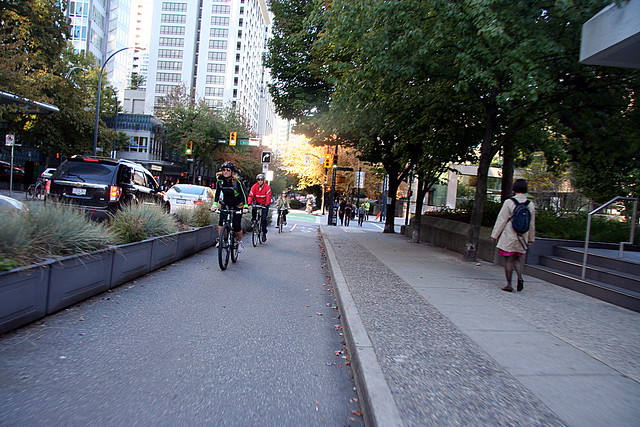
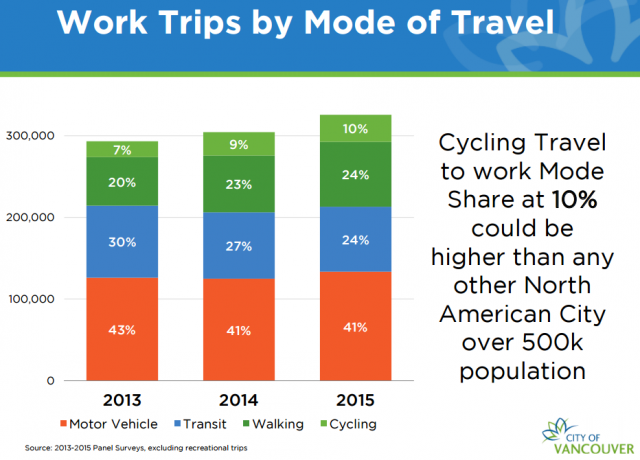
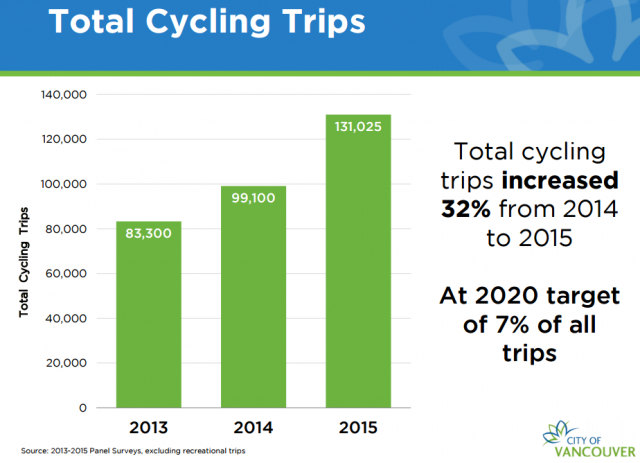
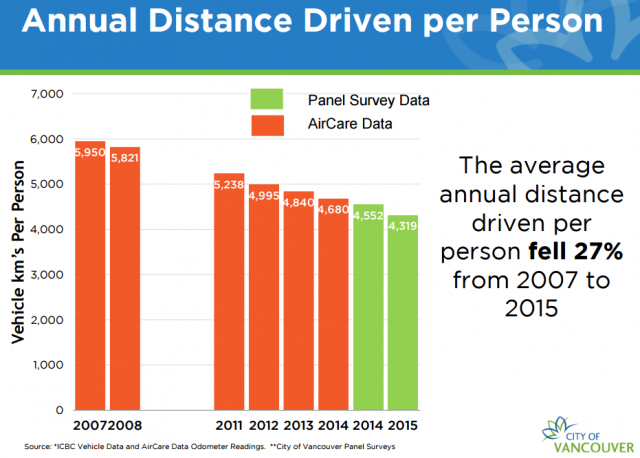
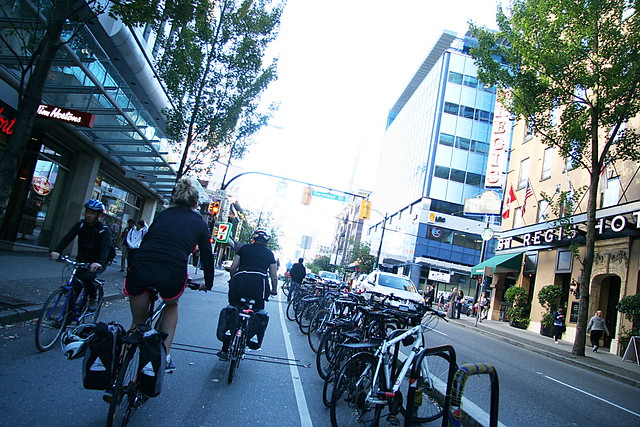
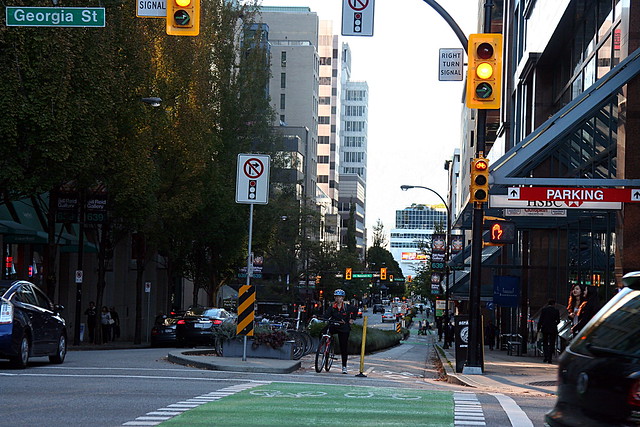
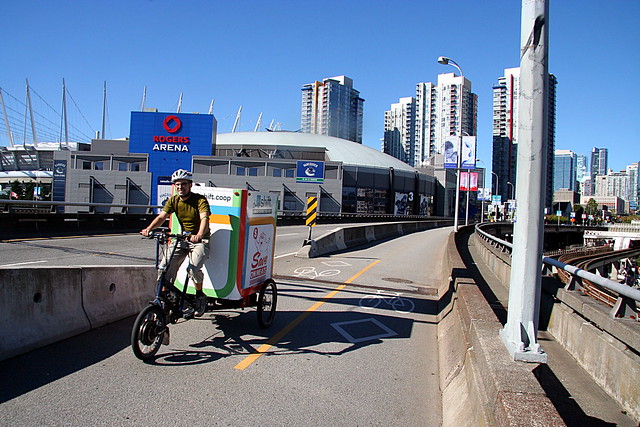

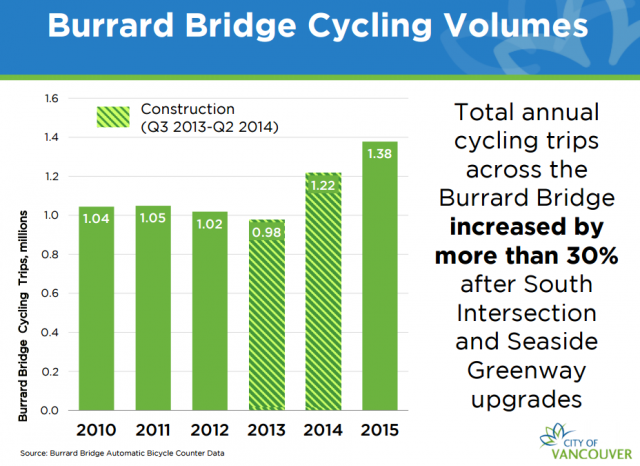



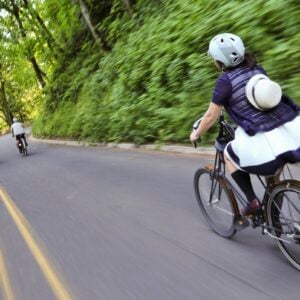
Thanks for reading.
BikePortland has served this community with independent community journalism since 2005. We rely on subscriptions from readers like you to survive. Your financial support is vital in keeping this valuable resource alive and well.
Please subscribe today to strengthen and expand our work.
This is an inspiring story!
LOVE the idea of protecting bike lanes with bike parking. A great reminder of what’s on the other side that could help cut down on intersection collisions, plus provides ample parking for the masses.
Well yeah. That’s what happens when you build cycling facilities for everyone instead of for people who already don’t mind riding in mixed traffic. It boggles my mind how Portland can get away with calling some of their recent bike projects quality cycling facilities. The 50’s bikeway comes to mind as an example of a utter failure that the city touts as a success. Look forward to the city referring to the future instantly-obsolete Foster bike lanes as a success as well.
As Vancouver BC has shown, it’s really not that hard to design quality cycling infra. They must be separated from motor traffic and parking, or they will not attract more riders.
Adam, perhaps you should consider working in transportation planning so that you can put some of your proposals into production.
Better yet work at the highest level of city administration or public works.
The Foster Road project is focused on safety and community livability, and I have no doubt it *will* be resounding success toward those ends.
The Foster Streetscape Project will be a success for people walking, businesses, and community livability. Those are it’s goals. However, it is absolutely not a bike project, and and chants from the city calling Foster a success for bikes will be dishonest. PBOT opted to retain Foster’s underutilized parking over providing a protected cycling facility, and as a result, we’re getting more 1990’s-style door zone bike lanes. It’s 2016, time to build real cycling facilities already.
Currently, you would have to be insane to want to ride on Foster. After the project, it will be possible to ride it safely. I’d call that an improvement.
Adam,
My guess is that the Foster bike lane will get a ton of bike traffic and even create some new bike traffic. Incremental change is better than nothing.
Incremental change that lures people into unsafe cycling facilities (i.e. unprotected painted door zone lanes next to 30+ mph motor traffic that disappear at all intersections) is a step backwards, IMO. This design does not follow international best practices. Foster’s speed and volumes (albeit likely to go down after the streetscape) warrant full separation. Given PBOT’s limited budget and exorbitantly long project timelines, if it’s not done correctly the first time, it will likely never be done right.
Like I’ve said in the past “better than before” is the absolute lowest benchmark possible. We can and should be aiming higher.
From a safety perspective the planned bike lane is a huge improvement over the current situation. It is also my understanding that speed limits will be lowered on Foster. Bike lanes may not always be ideal but they demonstrably encourage cycling. See the Williams piece below for a local example.
The Foster project covers 40 blocks of road, actually far more distance than that, since it is a diagonal road. The proposed Naito separated cycleway is supposed to cost $1.5MM for maybe 12 blocks. And making separated cycleways on Foster would cost more than on Naito, since parts of Foster would need widening to fit such cycleways. I doubt the city has the funds necessary ($10MM or more, I’d guess).
The implication that cycle tracks reduce collisions is simply untrue. Other than nearly eliminating the number of overtaken collisions, which is the rarest collision type in an urban environment (roughly 5%) they without exception increase rates (+15%) at intersections (roughly 70%) without infrastructure. So you reduce the rarest collision type in exchange for increasing the most common ones.
Granted being overtaken is one of the deadliest collision types, but it is quite rare, and in an urban setting the most common occurrence is in which it occurs is the cyclist maneuvering a lane change.
Cycling infrastructure has nothing to do with safety, it has everything to do with advertising alternative transportation choices and welcoming people to ride bicycles. By and large, the biggest cycling infrastructure it being pushed in many of the countries with socialized medicine is to reduce the costs of health care treatment for its citizenry. All the other benefits are simply icing on the cake. Which is also why they (the countries with socialized medicine) can afford to invest heavily in the bicycle infrastructure and do so more quickly. They do so because in the long run the benefits of it are cheaper than not doing it.
Incidentally, that is also why helmet use is promoted so heavily in the US (the exception being Australia). The medical and insurance are forced to look at each incident at the individual level to reduce claims and claim sizes, and since they have no influence on transportation about all they can do is recommend helmets as a way to reduce their risk exposure.
Believe it or not, the most damning studies on the subject are the Dutch and the Germans. But there are many more studies than those, and more that say cycle tracks increase incidents than say that they reduce incidents. And those studies that claim they reduce them almost always exclude intersection data.
When I say protected cycleways, I am assuming that they include protected intersections as well, which do reduce collisions.
What definition of “success” are you using for when you decide it wasn’t” I’ll ride on it, I suspect a lot of others will. So that’s a successful aspect.
Is it possible that success can mean something less than your particular ideal vision?
A project that follows international best practices for cycling infrastructure would be a good start.
There was no funding for an international best practice facility on Foster.
So sick of this excuse.
It’s hard to make decisions on funding, as it will take away from something else. I agree that we should have high standards, but funding is a key part of the puzzle.
This debate reminds me of something my first accounting professor said on the first day of class: “You can save the whales as much as you want, but it’s not going to happen unless you have funding.”
If lack of funding was the real problem then we would have gotten better bicycle facilities out of the $1.5 billion Orange Line project.
In an age in which laypeople, after an evening of web surfing can learn out about best practise designs, can no longer brush you off and keep you happy with some door-zone lanes. We know too much now.
It’s good to ask for better. If there’s no money for a long length, tell them you’d rather have a shorter length at higher quality than a longer length at lower quality if that’s the choice.
The experience in Vancouver has been that the higher quality infrastructure has attracted new people (from the latent demand) to cycling and this has created support for more of it.
I presume you’re voting for the gas tax?
I recall bike lanes next to parking planned on Foster.
This means converting the parking lane to bike lane and the bike lane to buffer/island will be that much easier in the future should the demand for such a facility grow to the tipping point.
PBOT’s active transportation funding was gutted by BAU commissioners and we appear poised to elect more BAU candidates. Doing the same thing over again and expecting different outcomes is…
paikiala,
Yes I am voting for the gas tax. It needs to be much higher but this is a good start and should make it easier to raise more in the future. As for Foster, if PBOT is actually considering some time in the future, converting the bike and parking lanes into protected lanes while removing parking, then that’s great. I just haven’t seen anything hinting to that in their plans. And given PBOT’s massive backlog of projects, I don’t see this happening any time soon anyway.
Why do we have to wait for more bike traffic to build protected? Roads are by default over-engineered for cars. Why can’t we do that for bikes instead?
The orange line was a trimet project. IMO. trimet has always been hostile to active transport.
I couldn’t tell from your article, is the 10% who bike from the 600,000+ City of Vancouver only, or the whole 2.3 million Frazier Delta region? The 7% figure for Portland is the City only; the Metro rate is much lower (but higher than most other places in the US).
Sorry for any confusion – the 10% is for the city proper. It doesn’t include the 8% or so of Vancouverites who work at home, though, which U.S. Census statistics would. So if you want apples-to-apples with U.S. cities the figure is probably around 9%, and the 2014 figure was around 8%. Still probably higher than Portland’s 7.2% as of 2014, hence our headline.
I lived and worked in Vancouver for 4 years. The City has similar, engaged citizen base and reluctant business community. However, I think they are much better at pushing back against the worriers, providing sound reasoning for decisions and pushing ahead with big moves. When they first added bike lanes to the Burrard Bridge there was so much opposition. They did a one or two year trial with Jersey barriers and they just built off the success of that project. Vancouver is also ruthless about parking: it is very expensive and in short supply. If you mispark, there is an army of towtrucks that will whisk your car away! They are also serious about traffic enforcement: they use unmarked cars (like old minivans) for radar patrols, they set up roadblocks to check for dui’s, and they will stand along the side of the road with parking spaces reserved behind the officer and simply wave people over who are speeding, driving recklessly, etc then write a batch of tickets. The City has invested heavily in clean, efficient rail tranist and in becoming a great place to walk and bike at the expense of being able to drive and park and it really shows. I love that City.
Wait, and despite all of that, people choose to live there, businesses remain profitable, and freedom is still a thing? Who woulda thunk it.
You hit on some great points, and I’d caution BP to not be too hasty to attribute the success primarily to protected bike lanes. My company is HQ’d in downtown Van and I travel there occasionally, mostly driving from Oregon when I do. It’s one of the more difficult cities I’ve driven in – especially to find parking. Last year we looked at moving there but the numbers didn’t pencil out, so I turned down the promotion. It’s still CRAZY expensive, and many of my coworkers don’t own cars as a result, or at most have one they split with their spouse. I think the public transportation is really good there, and I think that’s a huge contributor to using a bike for the ‘last mile’ or so (as we’ve seen with Caltrain adding bike cars here in the bay area). I haven’t polled our staff there but I’d be amazed to find even a few who regularly use a car for their commute (when I originally interviewed with the CEO, I’d gotten there early and he’d just arrived from a fairly long bike commute and excused himself to grab a quick shower).
Oh man, now you’ve got me missing Licorice Stout at the Alibi Room!
Your description of Vancouver BC sounds real as you describe it being very difficult to drive, and park in…and very expensive to live in. If those things are what Portland residents want for Portland, I suppose that makes VBC for them, a good model.
The picture of a long line of parked bikes across from the St Regis Hotel was encouraging, but other than that, in the pictures, there doesn’t seem to be many people riding bikes. By the pictures that’s in fair weather too. Let’s see some pictures of the turnout when it’s raining.
Protected bike lanes…at least a basic north-south, east-west cross town system of them, would, I think, would be good bike infrastructure for Portland, and other cities in the metro area. I’d be enthusiastic to see something like that come together out here in Beaverton or Hillsboro and so on, but so far, that’s an idea seeming to not be on local leaders, or residents consciousness.
I wonder some, about where VBC’ city council’s support came from, for what apparently was a rather dramatic move towards bike infrastructure expansion, in the face of also apparently considerable resistance, at least initially, from the business community against that expansion. What residents of the city may have been backing up the city council? If it was a lot of grass roots, working class people, that would be good, but in a city said to be very expensive to live in, that support may be a bit hard to figure.
I’ve seen traffic law enforcement work to create astronomical cycling numbers in the near-complete absence of any other measures. I have yet to see infrastructure enhancements work as stand-alone measures to achieve abundant cycling. Infra seems to work well with traffic law enforcement, but why start with the least effective piece?
Sounds like it might all depend on a bit of political backbone. You don’t need to worry about us building a world-class separated bike infrastructure without enforcement, because it’s not going to happen. We can’t do either without some spineful leadership.
“In summer 2013 the council took a difficult vote, in the face of intense criticism from residents of a wealthy seaside neighborhood, to use traffic diverters to convert a busy arterial called Point Grey Road into a residential street and all-ages bikeway.”
Ahem…7th Ave Greenway…will Portland’s City Council make the right move (also the cheapest) or will they succumb to the protestations of a handful of Irvington residents?
Ah, political courage. A bit of a rare commodity these days.
But there is little real danger, given th successes in other cities.
More protected and semi-protected bike routes to come, here in Vancouver. Plus filling in the gaps in our bike route system. Our ‘Ungap the Map’ campaign.
Hooray for them!
The SeaCyle video is great, especially the ‘before’ inset clips. However it appears the ped and bike increase (7% combined) is largely due to a mode share shift away from transit (6% decrease), with maybe a small but negligible decrease in auto use. It would be interesting to know why transit is down, and how those shifts fit with TransLink’s goals, which manages all of the systems.
I noticed the same thing. Didnt they add new rail lines for the Olympics? What happened?
It was considered a temporary demonstration.
https://en.wikipedia.org/wiki/Vancouver_Downtown_Historic_Railway#2010_Olympic_Line
These mode share numbers are for the City of Vancouver only, 25% of the region, and are for commute trips only. So they don’t indicate an overall fall in mode share for Translink which is in fact increasing. Before the Olympics, Translink did add a new metro line from Vancouver to Richmond and the Airport, and that has been running at at least 125,000 daily boardings, so it is going strong. Another issue is that this City of Vancouver mode share data is from surveys and isn’t always that accurate.
Another thing I LOVE about Vancouver related to biking is Pacific Spirit Park. I Big, forested park on the edge of town crisscrossed with trail (Sound familiar?!) Vancouver has a great mix of trails that are ped-only, leash-optional, no dogs, and shared use-allowing bikes! The City has set up a really great recreational system that preserves a ton of natural openspace and sets up realistic options for everyone. This could be a great model for Forest Park!
http://www.hr.ubc.ca/health/files/Pacificspiritmap_1.pdf
I just got back from an Amtrak-enabled bike trip to Vancouver, BC, and I rode the Burrard Bridge every day. It makes all of our shared-mode bridges very, very sad by comparison. Even with one end of it under construction.
I woulda taken a pinche taco in payment, but that would mean riding over to Cambie St.
And here I thought Vancouver was just some podunk suburb to the north. Who knew it had all this great infrastructure?
In Canada it’s THE big west coast city, as important as L.A. is in the States.
Nice snark, or if not DO NOT carry grenades around with you. http://www.cnn.com/2004/US/02/16/border.grenade/
So an inert replica hand grenade. Nothing to see here.
There’s a humourous aside lurking here about confusing your Vancouvers, but you might have to look harder. 😉
One crucial political difference: Gregor leads a political party (Vision Vancouver) that has had a majority for the whole time he has been mayor, which has meant he always has the votes for bike infrastructure.
Not to mention that they don’t have Portland’s awkward weak mayor system. (AFAIK).
We have a very weak mayor system in BC. The party system in Vancouver (almost unique to Vancouver in civic politics in Canada), makes the mayor a pseudo-strong mayer.
“Less exciting is the fact that the long-funded downtown Portland protected bike lane network that led me to title that 2013 post “A preview of Portland?” has yet to even start its public outreach process here in the south.”
Assuming that public outreach for the Central City Multimodal Plan even starts this year, it’s difficult to imagine anything being constructed this decade. Look at the schedule for the Foster Road project:
January 2012: first open house
2012-2014: Stakeholder Advisory Committee meets
June 2014: Council approves plan
Fall 2016: Construction documents expected to be complete.
Early 2017: Construction expected to begin
I would love to hear anyone explain why a road diet and streetscape improvements need 5+ years of public process and design work.
It’s actually pretty simple, and applies to both Foster and the Central City project: Federal transportation funding is typically awarded on a five-year cycle. So the money is awarded, but takes up to 5 years to actually arrive. For example, the current round of Regional Flexible Funds is for the 2019 to 2021 timeframe, with design money released in 19/20 and construction money in 20/21.That’s why we need local funding to do projects more quickly.
Great job, The Good Vancouver! We got some work to do to catch up, thanks for the inspiration!
Used Google Street View on Point Grey Road and used the historical imagery feature, absolutely gobsmacked at the infrastructure changes. Mind-blowing and a tough pill to swallow that there is such lack of vision or at least WILL here in PDX.
We have a very weak mayor system in BC. The party system in Vancouver (almost unique to Vancouver in civic politics in Canada), makes the mayor a pseudo-strong mayer.
And they aren’t done:
http://vancouver.ca/streets-transportation/point-grey-cornwall.aspx
Ah! reading the press releases rather than the 95 page actual Transportation-panel-survey-2015-final-report numbers.
The press summary was what they were handed, not the real numbers.
Does this mean we don’t have to travel as far for international study tours?
I propose a new law: If your’e on record of complaining that new bike infrastructure will kill business and then turns out you’re wrong wrong wrong, you owe 25% of your increase in profits to help pay for similar infrastructure.